English Classic Dishes
English cuisine, like the country itself, is now a mixing pot of different cultures and flavors. This has influenced and evolved the English food scene to a whole new level. However, it still has a long history of English classic dishes which have stood the test of time, and remain popular across the country.
Traditional English cuisine gained a poor reputation throughout much of the 20th century due to food shortages and poor quality produce compounded by two world wars. But since the turn of the millennium British food in general experienced a great revival. This has improved the image of English cuisine, and updated some historical classics.
It is difficult when talking about English dishes to refrain from calling them British dishes, as there is so much culinary overlap between the countries of the union. In anticipation of a future article on Classic Scottish or Welsh dishes, we have maintained this article for English dishes, with an English origin.
If you visit England here are 20 English classic dishes to try on your travels.
1. Fish & Chips
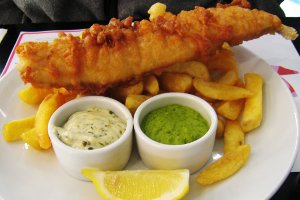
A combination of fried battered fish and chipped potatoes (French fries) slathered in salt and vinegar. Traditionally cod is used for the fish, but haddock, plaice, hake, pollock and coley are popular alternatives. A common takeaway meal throughout the UK. With a resurgence in promoting well prepared British classics, you can now find interpretations on this dish in high-end restaurants as well.
2. Full English Breakfast
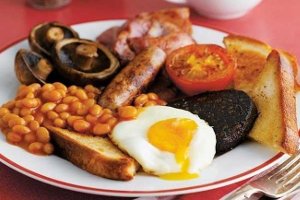
The king of all breakfasts; a behemoth of epic proportions to start the day. Sausages, back bacon, eggs, grilled tomatoes, fried mushrooms, baked beans, black pudding and toast in various protein and carb laden combinations.
Born from the excesses of Victorian England and the booming British empire. A veritable feast that is often used to cure a hangover or prepare the consumer to build a house.
3. Cottage / Sheppard’s Pie
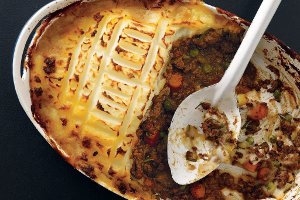
A meat filled pie with mashed potato topping. The meat filling uses either beef (cottage pie) or lamb (Sheppard’s pie) cooked in a gravy sauce with onions and other vegetables. Historians believe the pie became popular as a way to use leftover ingredients from a family meal in the 18th century, and when the use of potatoes became more widespread.
4. Cornish Pasty
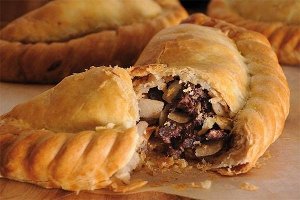
There are various forms of meat pasty, but undoubtedly the Cornish pasty is the most famous variety. A short crust pastry circle filled with beef, onion, potato and swede, then folded into a semi-circle and the circular edge crimped. It is then baked in an oven.
The Cornish pasty provided Cornish miners with a delicious lunch to carry. The crimped edge acted as a handle to hold while eating with coal soiled hands, and then discarded after use. The Cornish pasty has a Protected Geographical Indication (PGI) status in Europe.
5. Bangers & Mash
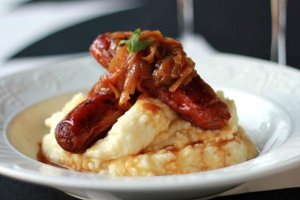
A straightforward dish of English sausages and mashed potatoes. Commonly served with a gravy sauce, peas and fried onions. The sausages are often Cumberland sausages, although any variety can be used. The term ‘banger’ originates from sausages made in the UK during World War I, when a shortage of meat meant sausages were of a poor quality with more water and filler. The water often caused the sausage to split and explode making a popping noise, hence the term ‘bangers’. These days you will find bangers and mash made with a higher quality premium sausage. The dish itself is a common English pub meal, which can vary in quality depending on the establishment.
6. Jellied Eels
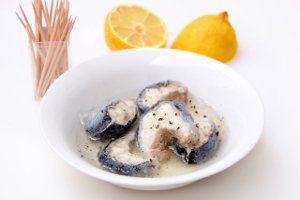
Jellied eels as the name suggests is literally eels in jelly. It is a dish particular to the East End of London, and until recently was uncommon outside of the capital. A recent surge over the last ten years has seen jellied eel sales increase across the UK.
The dish originated in the 18th century using native freshwater eels from the River Thames as a cheap and nutritious meal for working class families in East London. The eels are chopped and covered in a spiced gelatinous stock which is allowed to set. Jellied eels are sold in the famous pie mash & eels shops of London, where jellied eels are served with pie and mash (see below) another famous London dish.
7. Steak & Kidney Pie
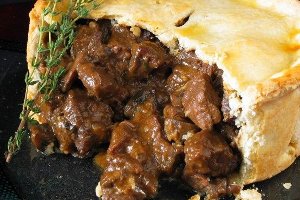
The steak and kidney pie is an English savory classic pie, filled with diced beef and chopped kidneys in a rich beef gravy with onions. The kidneys are those from a cow, pig or lamb.
The gravy is typically made from the broth of salted beef. It is often flavored with Worcestershire sauce and black pepper, which were traditional ingredients back in the 19th century when the pie became popular. The crust is usually a hot water crust pastry, puff pastry or shortcrust pastry. The pie is a close relation of the steak and kidney pudding, which has a similar filling but is encased in a delicious soft suet pastry.
8. Sunday Roast
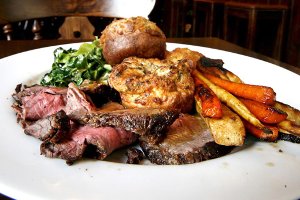
The majority of the dishes on this list maybe English classics, but how often are they cooked in English homes? Perhaps once in a while, but more commonly eaten at a British restaurant or pub. The Sunday roast is the standout exception, in that it is still a common weekly ritual for many families in England and across the UK.
Traditionally, the Sunday roast a big family meal consisting of meat, vegetables and potatoes. The meat can be beef, pork, lamb, chicken, turkey, duck, goose or game in a large joint or whole bird roasted in the oven.
Vegetables are boiled, steamed or roasted and chosen from a selection of seasonal vegetables including peas, cabbage, cauliflower, broccoli, green beans, carrots, parsnips, turnips or swede. The potatoes are boiled or mashed, but roast potatoes are the most popular choice, with much discussion and effort put into creating the perfect ‘roaster’.
Depending on the type of meat used, a variety of accompaniments and sauces are traditionally used. Yorkshire puddings, English mustard or horseradish sauce with beef. Mint sauce or recurrent jelly with lamb. Sage and onion stuffing or apple sauce with pork. Sage and onion stuffing, pigs in blankets or bread sauce with chicken.
The origin of this English institution has religious roots. After church on a Sunday the family would often gather at the family home for a large meal together. A large joint could be left to roast while the family were away at the church.
9. Pork Pie
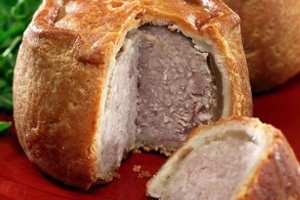
The English are a pie loving nation by nature, and we are onto pie number three already. The pork pie is usually served cold and is a hot water crust pastry with a chopped pork and jelly filling.
One of the most famous regional varieties is the Melton Mowbray pork pie, named after the Leicestershire town where it was created in the 18th century. Today, the Melton Mowbray recipe is protected by a European Protected designation of origin order.
Another common recipe is the Yorkshire pork pie. You can find pork pies across England, often as mass produced pie sold in supermarkets. But if you intend to try a pork pie, try to find a handmade artisan pork pie from an independent bakery or butchers. Its more often than not worth the search.
10. Pie & Mash
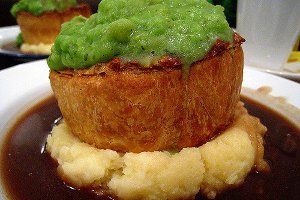
More pies? Sure why not. Pie and mash is a traditional London dish served with jellied eels, and sold in pie mash and eel shops. It was historically eaten by the working classes of London as a cheap and hearty meal to keep the workers going.
The London version of the pie is traditionally a minced mutton and cold water pastry pie. These days the dish is popular across the country and can consist of a pie with a variety of traditional and exotic fillings. Steak and kidney maybe the benchmark for the traditional English hot pastry pie, but now the steak & ale, chicken & mushroom, chicken & leek, and meat & potato pies have become more popular.
With a recent revival of the dish, more adventurous fillings are created by modern pie makers. A great example is the award-winning British pie shops in Bristol, England – Pieminster. The Matador (British beef steak, chorizo, olive & butter bean) and the Deer Stalker (wild British venison, bacon, red wine & green lentils) are just a couple of their delicious pies served with mash on enamel plates. Check them out if you’re in the city of Bristol, although they have expanded to other cities now.
11. Toad-in-the-Hole

Luckily, the ominously named toad in the hole does not contain any warty amphibians. This simple dish is every dietitians worst nightmare – a tray full of sausages baked in a batter. The batter pudding is the same style as that’s used for a Yorkshire pudding served with a roast beef Sunday roast. The toad-in-the-hole can be served with onion gravy, vegetables and mashed potato.
In the past a toad in the hold was any leftover meat recooked in batter, or a piece of beef, steak or offal cooked in a Yorkshire pudding. This is no longer the case, and sausages are generally always used in the modern toad-in-the-hole. Evidence for the original toad-in-the-hole recipe dates to the early 18th century.
12. Ploughmans Lunch
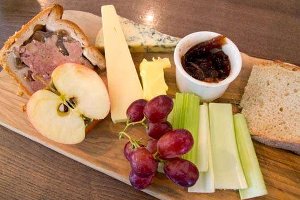
A ‘ploughmans’ is a cold platter of cheeses, bread, onion and pickles. Extras may include cold cuts of meat, salad, hard boiled eggs and apple.
Cheese and bread have been a staple of English inn and tavern food since inns and taverns were built. Bread became popular in medieval times, and the English have been enjoying bread, cheese and a beer ever since.
The first recorded mention of the dishes origins are found in a medieval poem called Pierce the Ploughman’s Crede written in 1393 – “Both bred and ale, Buttre, melk, and chese”. This combination of ingredients not only served tavern customers, but as the name suggests was a meal for rural workers of the land. Such food was easily carried to the field for consumption. The modern ploughmans will consist of almost any combination of cold served food, with locally sourced quality produce a popular selling point.
13. Spotted Dick
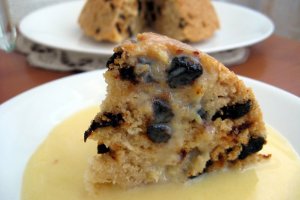
For all our sweet tooth readers out there, we have finally reached the desert section. Let’s kick things off with the wonderfully named English classic, the spotted dick.
Dried fruit in a sweet suet pudding and served with egg custard. In true English tradition this name is straight out of a Carry-On movie script, and we wouldn’t bet against it being used in one of those films back in the day. The true origin of the name is not fully understood. The spotted element is obviously the dried fruit, but the word dick is less clear. The earliest records show spotted dick being prepared in England in the 19th century.
14. Trifle
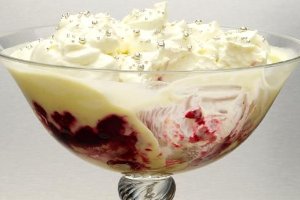
A Travel Mono personal favourite. We always create an awesome sherry trifle in the UK office at Christmas. A layer of sponge fingers soaked in sherry on the bottom of a large dish, covered with a layer of fruit pieces in fruit jelly, then a layer of egg custard above that, and finally a layer of whipped cream on the top. Desert heaven!
The dish is flexible and layers are often interchanged, multiplied or modified to personal preference. Port or Madeira wine can be used to replace the sherry, and the fruit pieces fresh or tinned. Chocolate, coffee, ginger, cinnamon or vanilla are typical flavorings for modifying a trifle.
15. Bread and Butter Pudding
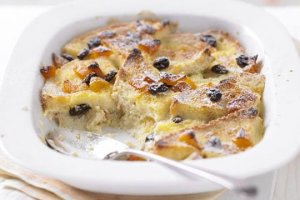
In this simple yet delicious desert, slices of buttered bread are layered into a dish with scattered dried fruit. It is sprinkled with demerara sugar and covered in an egg custard mix to be baked in the oven. It is served with additional custard, cream or ice cream. More upscale versions are made using brioche or panettone style breads.
16. Sticky toffee Pudding
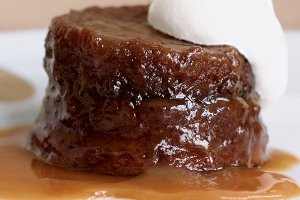
Sticky-gooey-ultimate-stodge. A moist sponge containing chopped dates and covered in a thick toffee sauce. If a decent trifle is our favourite desert, the sticky toffee pudding is a very close second. You will see this sweet delight served with custard or cream, or at its best – a scoop of homemade vanilla ice cream. This is the king of desert comfort foods.
It became popular in the North of England in the mid to late 20th century. Rumor has it, the recipe was given to a hotelier in Northern England by Canadian airmen in World War II. That would technically make the sticky toffee pudding Canadian. But as it rose to prominence in England, we are claiming it! Hmm, Controversial!
17. Treacle Tart
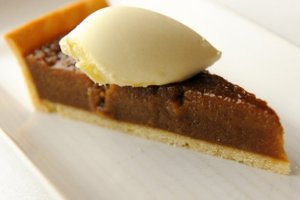
This English tart consists of a shortcrust pastry base filled with a Syrup and almond filling. It is served warm with a scoop of ice cream, custard or clotted cream. The filling can be modified with lemon or cream, and minced almonds, breadcrumbs or oatmeal can be used for thickening the filling mixture. Golden syrup is used instead of treacle despite the name.
A favourite desert of bespectacled wizard Harry Potter in JK Rowling’s famous novels. If its good enough for a prodigious wizard, its good enough for us.
18. Cream Tea

Cream tea is an afternoon meal, consisting of hot tea with scones, clotted cream, and jam. It is a common tradition in the South West of England and particularly the counties of Devon and Cornwall. However, you will find it across the country these day; especially in the high end traditional hotels of the capital. The style of cream tea local to Devon is another English dish to have attained protected status within the European Union under the Protected Designation of Origin scheme.
19. Eton Mess

The Eton mess is a pile of broken meringue pieces with strawberries. Maybe it looks a mess, but it tastes wonderful. It is suspected it is named after Eton college, and the school still serves the desert during its annual cricket match against Harrow. The Eton mess will be often served with strawberry syrup, whipped cream or ice cream. Variations include bananas or other fruits replacing the strawberries.
20. Bakewell Tart

The Bakewell tart is a shortcrust pastry tart, linked to the Derbyshire town of Bakewell. Similar to the treacle tart pastry, but with a filling of jam, frangipane and topped with almonds. The Bakewell tart was an evolution of the Bakewell pudding which was created in Bakewell in the 19th century. The original pudding was a flaky pastry with jam and almonds. It is not clear if the Bakewell tart also originated in Bakewell itself, but there are still strong links.
A variation of the Bakewell Tart is the Cherry Bakewell. Essentially a similar tart but covered with fondant icing and a cherry. The Cherry Bakewell was made famous by the British cake making company Mr Kipling who mass produced the Cherry Bakewell cup cake for supermarket shelves.
Thats brings us to the end of our list of English classic dishes. We hoped you enjoyed our article and inspired you to try some of this traditional English cuisine.
If you have any comments, maybe you found our inclusion of the sticky toffee pudding controversial, or we have left out your favourite dish from out list. Please let us know in the comments below.

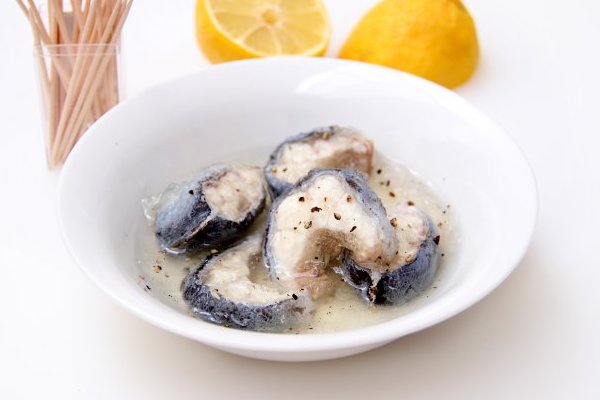
1 Comment